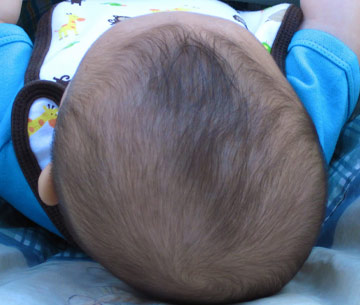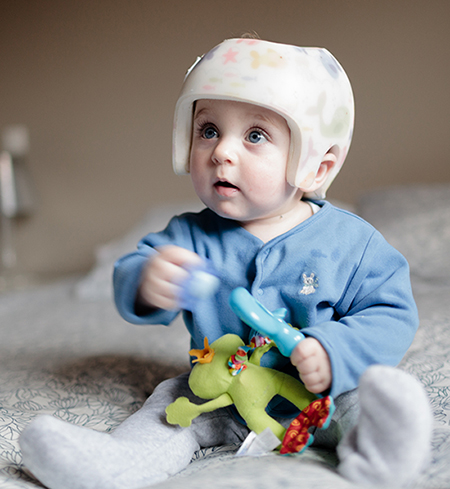Plagiocephaly (Flat Head Syndrome)
Our craniofacial team are experts at diagnosing and treating plagiocephaly. This common condition leads to flattened areas of an infant’s skull. For many babies, treatment may be as simple as adjusting their sleeping and resting position.
At OHSU Doernbecher Children’s Hospital:
- We examine more infants for plagiocephaly than for any other craniofacial condition.
- We are experts at seeing the differences between plagiocephaly and craniosynostosis.
- After diagnosis, we will guide you through simple steps to reshape your infant’s head in the first months of life.
- If your baby needs a helmet to adjust their head shape, we will help you set up a plan and manage treatment at home.
Understanding plagiocephaly
What is plagiocephaly?

Plagiocephaly is a Greek word that means oblique (slanted) head. It occurs when one side of a baby’s head is flat due to an unusually shaped skull. For many babies, the condition corrects itself over time.
Plagiocephaly is sometimes called flat head syndrome. The most common form is called positional plagiocephaly, because the baby’s head is shaped by its position before or after birth.
When plagiocephaly is symmetrical (flattens both sides of the head), it may look similar to other conditions. At Doernbecher, we are experts at seeing the differences between these conditions to make the right diagnosis.
What causes plagiocephaly?
Many children are born with heads that are slightly uneven, and parents and providers may not notice an unusual head shape early on. Because the skull bones are still forming in infancy, head shape often corrects itself within the first 6 weeks of life.
Plagiocephaly that needs treatment has been more common since the 1990s. This is when providers started to tell parents to put babies to sleep on their backs. Back-sleeping lowers the risk of Sudden Infant Death Syndrome (SIDS), but it increases the risk of positional plagiocephaly.
Plagiocephaly develops before or after birth due to repeated pressure on one area of the skull. A baby’s head is soft and can flatten if it is in the same position for long periods of time.
Common causes include:
- Resting position: Plagiocephaly is most common in babies who spend long periods without changing positions in a crib, car seat or baby carrier.
- Certain health conditions: Some infants may stay in one position if their physical development is delayed or if tight neck muscles limit their range of motion.
- Premature birth: A baby born early has a softer skull that is more likely to have an unusual shape. Premature babies also move their heads less often, or they may be in a respirator where they have limited movement.
- Tight space during pregnancy or delivery: A pregnant parent with a small pelvis is more likely to have a baby with plagiocephaly. The condition is also more common for:
- Infants with large heads
- Twins or multiple births
- Firstborn children
- Infants born in a breech position
Symptoms of plagiocephaly
Common symptoms of plagiocephaly include:
- Head tilted to one side
- Flat area on one side or on the back of the head
- An ear pushed forward on the same side of the head as the flat spot
- A bulging forehead on the same side of the head as the flat spot
- Uneven cheekbones, eye sockets, or lower jaw
Symptoms of plagiocephaly may be confused with signs of more serious conditions. For that reason, many providers refer infants with signs of plagiocephaly to experts for diagnosis. Our plagiocephaly clinic is the only one of its kind in Oregon.
Diagnosing plagiocephaly
When your child is referred to OHSU, our specialists in skull conditions will do a detailed exam. This will include:
- Learning about your family’s health history
- Measuring your baby’s head circumference, width and length
- Looking for developmental delays
In rare cases, we may need an X-ray or CT scan to diagnose plagiocephaly.
Treatment for plagiocephaly
In many babies, the shape of the head will correct itself within two years. Often this happens when your child begins to sit up. Positional or helmet therapy may help.
Our experts will work with you to create a treatment plan for your child. Positional therapy techniques may include:
- Sleep/rest time: Change the position of your baby's head during sleep. You might lay your baby’s head at one end of the crib for naps and the other for nighttime sleeping. You can encourage your baby to move their head with a bright object or mobile outside the crib.
- Feeding time: Move your baby from one side to the other during feeding to reduce pressure on the flat spot.
- Sitting time: Adjust your baby’s position often. Don’t leave them for long periods in a car seat, infant seat, baby swing, baby carrier or other device that restricts their head movement.
- Tummy time: Let your baby lie on their tummy each day to strengthen neck muscles. Do this after each diaper change, adding a minute each day.
- Physical therapy: Use gentle, consistent daily exercises to help increase the range of motion in your baby's neck.
Repositioning works best for infants under 6 months old. After 6 months, it may be best to focus on tummy time and other strategies. Most children are mobile and move their heads easily at 12 months. This movement will help their head shape continue to improve.
If your baby’s plagiocephaly is moderate to severe, we may recommend using a helmet or headband to reshape their skull. Helmet therapy may also help if positional therapy hasn’t worked. Because this treatment can be hard for children, we only use it when there aren’t other options.
The helmet provides gentle pressure to slow head growth in some areas while allowing growth in the flat areas.
Helmet therapy works best if we start when your baby is about 6 months old. Babies wear their custom-fit helmet 23 hours a day for two to six months.

Additional services for plagiocephaly
We provide complete care for plagiocephaly, including follow-up care with a nurse practitioner and physical therapists who specialize in this condition. If your baby needs ongoing physical therapy, we will help you find a physical therapist close to your home.
If we recommend positional therapy for your child, you can meet with physical therapists to learn and practice techniques. Our physical therapists are always available to answer questions.
If your child needs a helmet, our nurse practitioner and a physical therapist will support you in managing this therapy.
Learn more
- Flat Head Syndrome and Your Baby, Healthychildren.org, American Academy of Pediatrics
- Positional Plagiocephaly, American Association of Neurological Surgeons
For families
Call 503-346-0640 to:
- Request an appointment
- Seek a second opinion
- Ask a question
Locations
Parking is free for patients and their visitors.
Doernbecher Children’s Hospital
700 S.W. Campus Drive
Portland, OR 97239
Map and directions
Find other locations across Oregon and in southwest Washington.
For referring providers
Refer your patient to OHSU Doernbecher.
Call 503-346-0644 to:
- Seek provider-to-provider advice.
- Request education about plagiocephaly or other conditions.